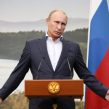
NORTH CAUCASUS-TESTED STRATEGIES USED TO COUNTER MARCH OF THE DISCONTENTED
Publication: Eurasia Daily Monitor Volume: 4 Issue: 78
By:

Russian police severely beat many participants in the April 14-15 demonstrations against President Vladimir Putin in Moscow and St. Petersburg. Known as the “March of the Discontented,” the rallies were organized by the “Other Russia” movement. Dmitry Peskov, Putin’s deputy press secretary, dismissed the recent demonstrations as “extremely insignificant.” Peskov insisted that the number of people who had actually taken part in the events was small. However, the measures that the authorities used against the unarmed demonstrators in the two largest cities were unprecedented in post-Soviet Russia. The law-enforcement tactics used against the president’s political opponents in fact resemble those that have been used to fight the insurgency in the volatile North Caucasus.
Other Russia was established last year, and it unites different political groups that dislike the Kremlin’s anti-democratic reforms (see EDM, April 2). The movement first came to public notice at the end of 2006, when it organized a rally in the center of Moscow. Other Russia activists appealed to the Moscow city government to stage a demonstration that would end in Vasilyevsky Spusk, near the Kremlin. According to Kommersant, Russian Interior Minister Ruslan Nurgaliev personally asked the city’s government to ban the demonstration (Kommersant, December 5, 2006).
After a wrangle between the opposition leaders and officials that lasted for several days, the city finally agreed to allow a “rally,” but not a “demonstration,” in the center of the city. Numerous police and army troops were moved into Moscow on the day of the rally. The staging area was surrounded by special-task police units and soldiers armed with rubber batons. A police helicopter circled overhead. At the same time officers from the Federal Security Service and the police organized crime department started to arrest opposition activists as they traveled to Moscow from other Russian cities to take part in the rally. Law-enforcement agencies ignored the fact that unarmed Russian citizens wanted to take part in a rally that had been sanctioned by the authorities. The fact that police from the organized crime department as well as from the department to fight terrorism and political extremism took part in these illegal arrests suggests that the authorities regard opposition activists to be as dangerous as the terrorists and rebels that operate in the North Caucasus.
During a March 3 rally in St. Petersburg, security measures against the opposition looked even more similar to special operations in the North Caucasus. The siloviki ignored standard procedures in an effort to neutralize the enemy. Several days before the rally, Federal Security Service officers in the town of Petrozavodsk abducted two local National Bolshevik activists who also belong to the Other Russia and took them into the woods (kasparov.ru, March 4). The officers handcuffed the activists, put guns to their heads, and threatened to kill them if they went to St. Petersburg to take part in the March.
Eduard Limonov, head of the National Bolshevik party and one of the leaders of Other Russia, was arrested on the day of the St. Petersburg rally. Limonov was “neutralized” as if he were leader of an illegal armed formation in the Caucasus (grani.ru, March 3).
Late last mouth, before an Other Russia rally in Nizhny Novgorod, the authorities conducted a special operation code-named “Fortress” (Gazeta, March 25). This tactical plan had been devised in 2005 for police and army units to use to prevent a large-scale attack in a city in the North Caucasus. The plan is used every time the special services obtain intelligence about possible armed attack on military and police facilities.
The fact that the same type plan of action was used in Nizhny Novgorod suggests that the Kremlin is significantly afraid of any real opposition movement. Up to 20,000 troops and police were involved in that sweep. Army posts were set up at all main entry points for the city. Police and FSB officers arrested all young men and women who were arriving in the city ahead of the rally. These people were taken to the gym of a local school, where they were fingerprinted and filmed by a video camera.
Early in the morning on the day of the rally, two local activists, Vyacheslav Lukin and Svetlana Somina, were kidnapped by FSB officers and taken to an open field outside the city. They were not released until the rally had ended (Gazeta, March 25).
For the April 14 rally, some 9,000 troops and police occupied the center of Moscow. According to Viktor Biryukov, head of the press service of the main directorate of the Moscow police, the center of Moscow had been divided into four quadrants to maintain “order.” A special command center staffed by FSB and police officers was set up to control the situation (Kommersant, April 13). There were rumors that a special army unit from Tambov, which had taken part in the Chechen war, had been deployed to the Russian capital for that event. The authorities did not conceal the fact that there were armed troops hidden in trucks ready for action.
Following procedures regularly used in Chechnya, the Moscow police swept the area ahead of the rally. Police and FSB officers arrested all young men whom they regarded as “suspicious” in the vicinity of the designated rally site.
On March 9, Putin met with FSB officers in the Kremlin and ordered them to provide security during the upcoming elections in Russia. Deputy FSB Chief Vladimir Bulavin, the executive head of the National Anti-Terrorist Center, pledged to fulfill the task successfully (Interfax, March 9).
The measures taken by the authorities after this meeting show that the Kremlin regards all Russians who dislike the government as potential terrorists. After six years of war in Chechnya, Putin’s version of the War on Terror has crept into the Russian heartland.




